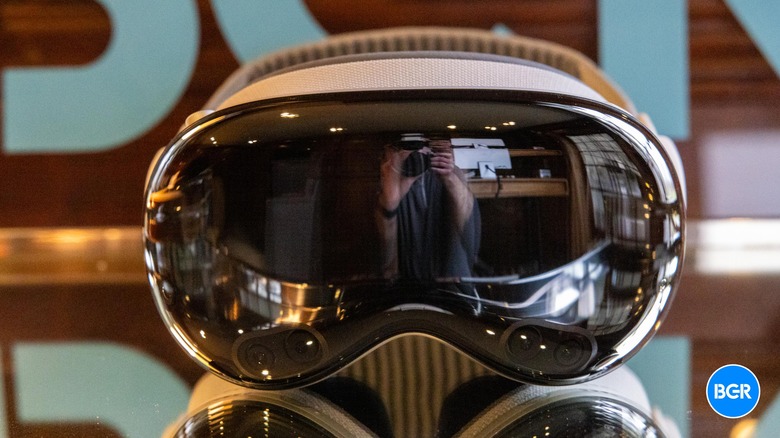This Is One Way Apple Might Make The Next Vision Pro Cheaper
Reports say that Apple wants to make a cheaper version of the Vision Pro spatial computer. Now, a new story from Korea details the kind of compromise Apple might be looking into as it tries to cut costs. Apple is reportedly interested in new OLED panels that could be brighter than the current model. However, these displays would have a lower resolution than the screens Apple uses for the first-gen Vision Pro.
The Vision Pro's crisp display is one of the product's highlights since it's responsible for the incredible images it can produce. If you've tried the Vision Pro during a demo session in an Apple Store, you've experienced its astonishing immersiveness. The screen is also responsible for that great passthrough video and AR spatial computing. That's all possible because of Sony's OLEDoS panels, which feature a resolution of 3,391 pixel-per-inch (PPI), higher than any other screen you might experience.
Apple is now looking to lower the resolution to 1,500 PPI, or less than half the resolution of the first-gen Vision Pro. The cheaper spatial computer would still feature a crisp display, albeit less sharp than the more expensive model.
According to Korean website The Elec, Apple is developing white OLED boards with a color filter on top that would feature red, green, and blue (RGB) patterns. It's a W-OLED+CF display, a technology that could improve the screen's brightness. Samsung is seen as a potential supplier.
The report says Apple wants to form the color filter on the thin-film encapsulation (TFE) covering the OLED panel. Another option is to use two glass boards, one for the color filter and one for the white OLED layer.
Apple reportedly prefers the first method, which will let Apple reduce the thickness of the cheaper Vision Pro. Making the spatial computer smaller than the first-generation model would likely be on Apple's list of priorities. The Vision Pro has seen some criticism for its weight.
However, mass-producing these W-OLED+CF displays won't be cheap if Apple chooses the all-in-one method. A low-temperature process is required to form the color filter on the TFE, so it doesn't damage the OLED panel.
Samsung is already familiar with this process, as it uses it to manufacture the displays of its foldable phones. The method is called color filter on encapsulation (CoE).
Still, the budget Vision Pro would need a much denser color filter than Samsung's foldables because of the high-resolution requirements. The Galaxy Z Fold 6 has a 374 PPI resolution. Making a 1,500 PPI panel using similar tech would increase costs.
The report says that Samsung will likely meet Apple's needs and develop the W-OLED+CF panel according to its needs. Samsung has been more active than competitors in investing in this particular OLED screen tech. It's looking to install research equipment for W-OLED+CF at its A3 facility.
If the information is accurate, it'll be interesting to see whether Samsung uses similar displays for its own mixed-reality headset. The company announced a partnership with Google and Qualcomm quite a while ago, but we've yet to see any products from it.
